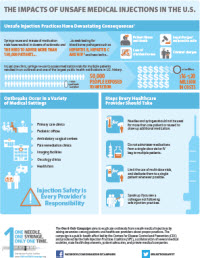Categories: Healthcare-associated infections, Injection Safety
November 28th, 2012 10:28 am ET -
.

The Impacts of Unsafe Medical Injections in the U.S.
Author: Centers for Disease Control and Prevention
Injection safety is part of the minimum expectation for safe care anywhere healthcare is delivered; yet, CDC has had to investigate outbreak after outbreak of life-threatening infections caused by injection errors. How can this completely preventable problem continue to go unchecked? Lack of initial and continued infection control training, denial of the problem, reimbursement pressures, drug shortages, and lack of appreciation for the consequences have all been used as excuses; but in 2012 there is no acceptable excuse for an unsafe injection in the United States.
Eradicating unsafe practices will take a multifaceted approach, and now is the time for action to ensure that no additional patients are harmed through unsafe injections. Today, the CDC and the Safe Injection Practices Coalition released new materials to make it easier for clinicians and others working in healthcare to learn and train others about following safe injection practices.
Two Birds with One Stone: Bloodborne Pathogen Training + Patient Safety – Enhanced PowerPoint
Healthcare providers or training managers who need to keep staff current on bloodborne pathogens training can now use a new presentation: “Safe Injection Practices: Protection Yourself and Your Patients – A Bloodborne Pathogens Training Activity.” This training was created to remind healthcare providers that measures they take to protect themselves from bloodborne pathogens and other exposures also protect patients from healthcare-associated infections. View the training on the One & Only Campaign’s website.
 Post a Comment -
Read more
Post a Comment -
Read more

Categories: Antimicrobial Resistance, Healthcare-associated infections
November 15th, 2012 8:39 am ET -
.

Chris Crnich, MD
Author – Chris Crnich, MD
Assistant Professor of Medicine in the Division of Infectious Diseases at the University of Wisconsin School of Medicine and Public Health and is the Hospital Epidemiologist at the William S. Middleton VA Hospital.
A significant proportion of antibiotic use in nursing homes is inappropriate. Inappropriate antibiotic use unnecessarily places residents at risk for adverse drug events and is the major driver of antibiotic resistance in nursing homes.
A traditional approach to the problem of inappropriate antibiotic use in nursing homes centers on educating the provider making prescribing decisions. The thinking goes, that if we can get providers to better understand the adverse consequences of antibiotics and increase their knowledge about antibiotic choice and dosing, the problem of inappropriate antibiotic use in nursing homes will go away. Unfortunately, it is not that simple.
Prescribing in nursing homes is unique in that most decisions to initiate antibiotics are made over the phone without the benefit of a clinical exam performed by the prescribing provider. Coupled with the clinical uncertainty created by the atypical presentation of acute illness in the frail elderly and limited access to diagnostic test results creates a perfect environment for overuse of antibiotics. When viewed through this prism, the likelihood of inappropriate antibiotic use is not simply determined by the provider but by the particulars of the resident’s presentation, accessibility to diagnostic tests, features of the nursing home staff primarily responsible for the clinical exam, as well as the quality of communication between providers and facility staff.
Recognizing that inappropriate antibiotic use is an outcome determined more by the nursing home system rather than an individual provider’s decisions and behaviors is an important step towards addressing this problem. With this in mind, future efforts to improve antibiotic use in nursing homes must begin to focus on strategies that: 1) standardize nursing assessments of the resident with suspected infection; 2) enhance the accessibility of clinical information and diagnostic test results, and 3) improve the quality of communication between providers involved in the antibiotic start process.
Implementing these types of interventions in the nursing home environment will not be without challenge but as Albert Einstein once said, “Insanity is doing the same thing over and over again and expecting different results”. Ignoring the important role of the system on antibiotic use will lead to more of the same. We can and must do better.
 Post a Comment -
Read more
Post a Comment -
Read more

Categories: Antimicrobial Resistance, Healthcare-associated infections
November 13th, 2012 6:46 am ET -
.

Ramanan Laxminarayan, PhD
Author – Ramanan Laxminarayan, Ph.D.,
director of Extending the Cure (ETC)
Our ability to conquer microbial diseases with antibiotics goes back only 70 years. Yet, the inevitable and rapid development of resistance to these miracle drugs may soon usher in an era where common infections are once again deadly or very costly to treat.
Since its inception in 2007, Extending the Cure (ETC) has worked to inform stakeholders of the magnitude of this unfolding crisis and to offer broad-based economic solutions based on the idea that antibiotic effectiveness should be managed as a shared societal resource, much like forests or fisheries.
As a capstone to our efforts, ETC and the CDC have brought together representatives from leading research, medical, and trade organizations to express our mutual commitment to extend the useful life of antibiotics. At the start this year’s Get Smart about Antibiotics Week, my colleague and close collaborator, Arjun Srinivasan, and I will unveil a consensus statement on antibiotic resistance from 22 national health organizations at a joint telebriefing on November 13.
 1 Comment -
Read more
1 Comment -
Read more

Categories: Healthcare-associated infections
October 25th, 2012 11:03 am ET -
.

Jan Patterson, MD, MS
Author: Jan Patterson, MD, MS, FACP, FIDSA, FSHEA, CPE, FACHE
President of the Society for Healthcare Epidemiology of America
Change is never easy and old habits are tough to break. Since preventable healthcare-associated infections (HAIs) affect one in 20 patients, the healthcare community – from the C-Suite to the front line – must come together to change practices that allow HAIs to impact the quality and safety of patient care.
Last week, medical researchers and practitioners from across the world convened in San Diego for IDWeek 2012TM, the first joint annual meeting of the Infectious Diseases Society of America, Society for Healthcare Epidemiology of America, Pediatric Infectious Diseases Society and HIV Medical Association. The meeting covered the progress we’ve made in eliminating HAIs and what more we need to do to confront these issues. Even with the evidence that backs up core infection control practices, without behavior change, science can only accomplish so much.
Cultivating a Culture of Safe Care
Creating change in healthcare requires knowledge and practice of quality improvement. Professionals must know the evidence-based measures and must also understand standard quality improvement tools to implement them. Similar to corporate cultures, healthcare management needs to show support for these measures for them to be embraced and put into daily practice at the bedside.
 3 Comments -
Read more
3 Comments -
Read more

Categories: Healthcare-associated infections
October 23rd, 2012 2:13 pm ET -
.
One Case Sparks National Action
Imagine… A patient goes to the doctor for a routine steroid injection. A couple weeks later, the patient feels sick – headache, fever and suddenly uncomfortable in bright light. Within days, the patient is admitted to the local hospital’s intensive care unit. Doctors discover that the patient has a life-threatening disease they’ve never treated before.
The medical team immediately calls the state health department to alert them of this rare illness. A short time later, public health is spurred into action, sparking a national investigation of tainted medication given to thousands of Americans.
No one ever knows when the next outbreak will hit. The keys to catching outbreaks fast are astute clinical teams, a strong state and federal public health system, and strong collaboration with a range of national and local organizations.
 20 Comments -
Read more
20 Comments -
Read more







